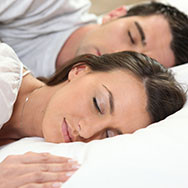How is couples’ sleeping time organized in France?
Nine in ten people in France are asleep from 1 am to 6 am, according to INSEE’s 2009-2010 Emploi du Temps (Time use) survey. Generally speaking, couples tend to synchronize their sleep: the members of 4 out of 5 couples go to bed and get up at the same times. The sleep of retired couples, non-working couples under age 60, and relatively well-off working couples is fairly synchronized whereas relatively disadvantaged working couples’ sleep is desynchronized: 18% of couples in which both partners are managers report desynchronized sleep compared to 25% of couples in which both partners are office workers; the respective time differences are 1’45” and 2’45”. The sleep of 27% of manual worker couples is desynchronized, by an average of three hours.
The impact of television
Drawing on three Emploi du Temps surveys conducted between 1985 and 2010, Capucine Rauch, a PhD student at INED, has shown that the amount of synchronized couple sleep fell in those 25 years. Aging, too, is implicated, whereas the rise in female employment has reduced desynchronization.
In 2009, regardless of social class, couple members slept an average of 13 minutes less together than in 1998 or 1985. Why? The answer is the amount of time spent watching television while one’s partner slept (30 minutes in 2009, compared to 15 minutes in 1985). However, while television helps to explain the decline in synchronized sleeping time, it is not the main cause.
Work is the main explanation of desynchronized sleeping in couples
The activity that bears the most responsibility for desynchronized sleep, accounting for 31 minutes, is paid work and the commutes associated with it, whereas television represents only 23 minutes on average for the total of period years. The most closely synchronized sleeping (average synchrony of 80%) occurs after days where both couple members are off work. Asynchrony does vary by social class, however. For manager couples it came to 15 minutes on average, whereas for office worker and manual worker couples—less free to choose their work hours, meaning that partners are more likely to work different hours—it comes to a full hour.
Desynchronized sleep reflects gender inequalities
The type of activities performed by the couple member who remains awake while their partner is sleeping reflect gendered task organization: women spend more of that time on housework than men (20 minutes versus 5 minutes on average), while men spend more of it on paid work than women (22 versus 9 minutes).
Likewise, having young children in the household impacts how women use the time during which their male partners are sleeping but has no significant impact on the time men spend while their female partner is asleep.
Source: Capucine Rauch, 2021, Inégalités sociales et désynchronisation du sommeil au sein des couples, Economie et statistique, Insee.
Contact: Capucine Rauch
Online: August 2021

